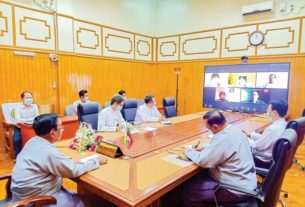After months of negotiations and failed promises, a proposed multi-billion dollar Myanmar port and special economic zone that could transform Southeast Asian trade appears back on track.
Thai banks aim to keep the project afloat with short-term loans until an expected Japanese loan of up to $3.2 billion can be secured, officials and sources famliar with negotiations told Reuters.
Thailand’s largest construction firm, Italian-Thai Development Pcl, signed a deal in 2010 to build a deep-sea port and Special Economic Zone (SEZ) in southern Myanmar’s coastal Dawei into Southeast Asia’s largest industrial complex.
But the project foundered, as the Thai builder failed to secure $8.5 billion to finance construction of its first phase — roads, utilities and a port.
Underlining Dawei’s strategic importance, Japan and Thailand have since intervened to rescue the project.
“Italian-Thai has had difficulty in mobilizing the funding. So now the Thai government has effectively taken over the project,” Thaung Lwin, chairman of the Dawei SEZ told Reuters. “The next step is to invite Japan”, which he said is committed to seeing the project succeed.
Since the Thai and Myanmar governments agreed on July 23 to connect Dawei to the Thai port of Laem Chabang, 100 km southeast of Bangkok, Thai banks led by Bangkok Bank and Siam Commercial Bank have arranged a 10 billion baht ($325 million) bridge loan to sustain it for another 8-10 months, Somjet Thinaphong, managing director of the Dawei Development Co, an Ital-Thai unit, told Reuters in an interview.
That loan would be followed by a soft loan from the state-backed Japan Bank for International Cooperation to finance the basic port and road infrastructure needed to push the project forward, he added. A source involved in the negotiations said the soft loan could total $3.2 billion. Thaung Lwin of the Dawei SEZ said he expected Japan to emerge as the project’s biggest shareholder.
As the former British colony embarks on its most dramatic changes since a 1962 military coup in what was then Burma, mega-projects like the $50 billion 250 sq km (155 sq mile) Dawei SEZ hint at what lies ahead. Super-highways, steel mills, power plants, shipyards, refineries, pulp and paper mills and a petrochemical complex are part of it, as are two golf courses and a holiday resort.
Road and rail routes could link Dawei to neighbors China, India and other parts of Southeast Asia, allowing cargo to bypass the narrow and congested Strait of Malacca to forge shorter trade routes from the Middle East and Africa to China and Japan. The Association of Southeast Asian Nations (ASEAN), a grouping of 10 countries, hopes Dawei will play an important role in its ambitions for a common market in 2015.
For Japan, a better-connected Southeast Asia makes it easier to sell their products and knit together a vast network of suppliers to Japanese-owned factories and manufacturing plants, which include autos and electronic goods.
“Before the yearend, we will have major progress,” Pisanu Suvanajata, Thailand’s ambassador to Myanmar, said in an interview with Reuters.
LOCAL ANGER
Just months ago, the project was nearly left for dead, a casualty of simmering local resentment and fragile financial backing. About 30,000 people, mostly impoverished rice, cashew and rubber farmers living in thatch-roof huts, are slated to be moved during 10 years of planned construction.
In the Dawei region, many worry about the potential environmental toll and health risks from a project that would be four times bigger than Thailand’s largest industrial estate, Map Ta Phut, where pollution between 1996 and 2009 may have contributed to at least 2,000 cancer-related deaths, according to environmental activists who sought legal action to halt the estate in 2009.
Emboldened by the government’s surprise suspension of the $3.6 billion, Chinese-led Myitsone dam project last year after weeks of public outcry, residents have pushed hard against Dawei. In response, the government scrapped plans for a 4,000 megawatt coal plant. That’s been replaced by plans for a “clean coal” plant that can generate 400 megawatts, said Thaung Lwin of the Dawei SEZ. So-called clean-coal technology involves capturing carbon dioxide and other toxic emissions, and either storing them deep underground or piping them to oil and gas fields.
“If it is clean coal technology, then we will allow it,” he added. “Our president visited Japan and saw the clean coal technology at J-Power Group.”
But that may not be enough to pacify local residents. Activists who have organized protests against Dawei say it is unclear what types of companies will set up there. Thaung Lwin said he expected Nippon Steel and petrochemical makers to build factories in Dawei.
Local activists raised a banner this week along a recently built highway from Dawei to Thailand that says: “Stop Building Another Map Ta Phut” in Dawei.


